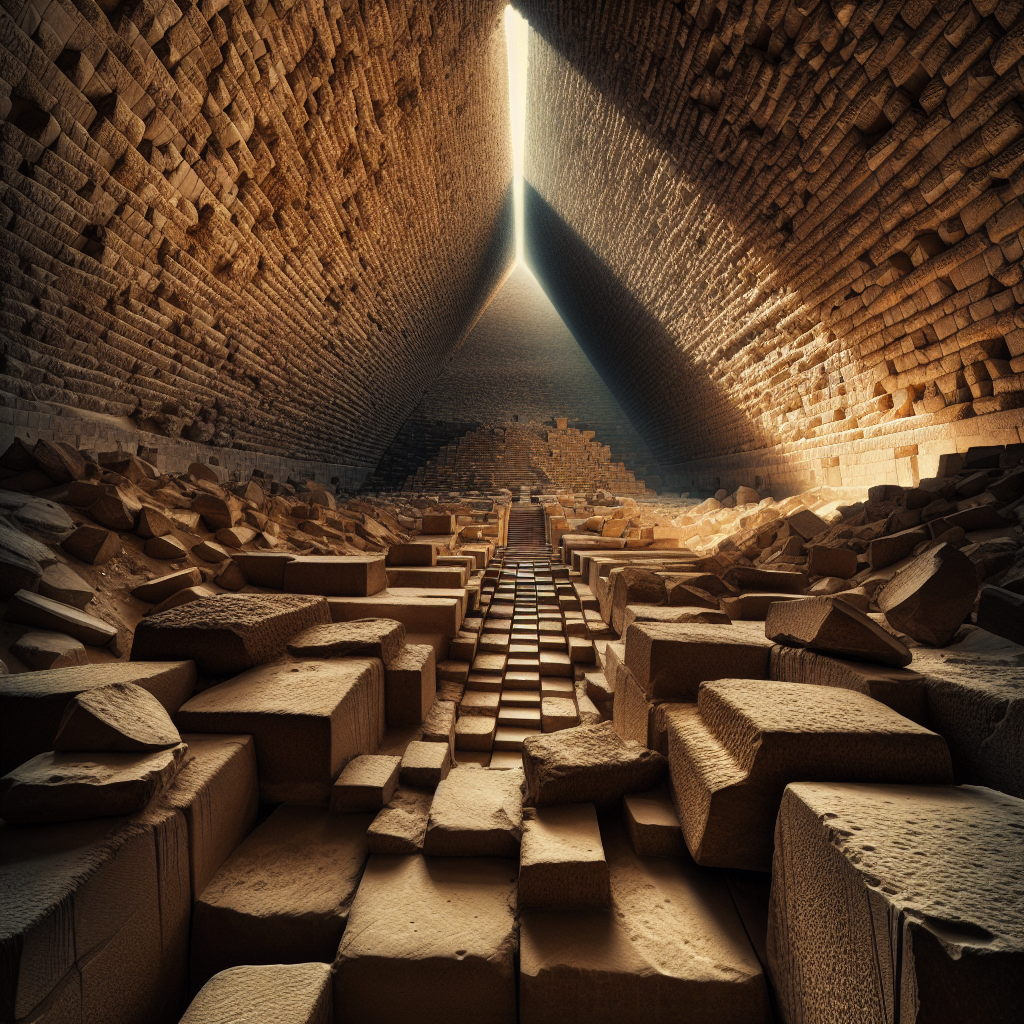The pyramids remind us that true architectural excellence transcends mere functionality to touch something eternal in the human spirit.
The ancient Egyptian pyramids stand as testaments to humanity's earliest mastery of mathematics, engineering, and sacred geometry. These monumental structures, built over 4,500 years ago, continue to inspire modern architects and engineers with their perfect proportions, sustainable design principles, and profound understanding of geometric relationships.
The Mathematics Behind the Monuments
The Great Pyramid of Giza embodies mathematical principles that modern science has only recently begun to fully appreciate. Built with a base-to-height ratio that approximates π (pi), and incorporating the golden ratio (φ) in its fundamental design, these structures demonstrate an sophisticated understanding of mathematical constants.
The precision is staggering: the Great Pyramid's base is level to within 2.1 centimeters, and its sides are aligned to true north with an accuracy of 3/60th of a degree. This level of precision, achieved without modern surveying equipment, reveals the ancient Egyptians' deep understanding of astronomy, mathematics, and engineering.
Sacred Geometry: The Language of Creation
Sacred geometry was central to Egyptian architectural philosophy. They believed that certain geometric patterns and proportions reflected the fundamental structure of the universe. Key principles include:
The Golden Ratio (1.618...)
Found throughout pyramid construction, this ratio appears in:
- The triangle formed by the pyramid's height and half its base
- The proportions of the King's Chamber
- The ascending passages within the structure
The Sacred Triangle
The 3-4-5 triangle, known to the Egyptians long before Pythagoras, was used extensively in pyramid construction. This right triangle ensured perfect 90-degree angles and stable foundations.
Geometric Harmony
The pyramids demonstrate how geometric shapes can create acoustic and energetic harmonies. The King's Chamber in the Great Pyramid resonates at specific frequencies that some researchers believe have healing properties.
Modern Applications of Ancient Wisdom
Contemporary architects increasingly draw inspiration from pyramid design principles:
Sustainable Design
The pyramid shape naturally promotes:
- Excellent structural stability with minimal materials
- Natural ventilation through convection currents
- Optimal solar orientation for passive heating and cooling
- Resistance to earthquakes and extreme weather
Biophilic Architecture
Modern buildings incorporating pyramid geometry report:
- Enhanced occupant well-being
- Improved air quality
- Better natural light distribution
- Reduced energy consumption
Notable Modern Examples
The Louvre Pyramid, Paris I.M. Pei's glass pyramid perfectly demonstrates how ancient proportions can enhance modern spaces. The structure uses the same angle as the Great Pyramid, creating a harmonious blend of old and new.
The Luxor Las Vegas This 30-story pyramid hotel incorporates ancient Egyptian proportions while utilizing modern materials and technology, proving the timelessness of pyramid geometry.
The Memphis Pyramid, Tennessee Originally built as an arena, this structure shows how pyramid shapes can accommodate large, open interior spaces while maintaining structural integrity.
Engineering Lessons for Today
Foundation Technology
The Egyptians' technique of creating perfectly level foundations on irregular terrain influences modern construction. They used water-filled trenches as natural levels, a principle still applied in contemporary surveying.
Modular Construction
Pyramids were built using standardized blocks, prefiguring modern modular construction. This approach enabled:
- Quality control
- Efficient transportation
- Precise assembly
- Scalable construction
Workforce Organization
The pyramid builders' project management techniques inspire modern construction management:
- Specialized teams for different tasks
- Rotation systems to prevent fatigue
- Integrated supply chains
- Clear hierarchical communication
The Spiritual Dimension in Modern Design
Beyond practical applications, pyramid geometry addresses humanity's psychological and spiritual needs:
Meditation Spaces
Many modern meditation centers incorporate pyramid shapes, finding that the geometry enhances:
- Concentration
- Energy flow
- Acoustic properties
- Sense of sacred space
Healing Architecture
Hospitals and wellness centers increasingly use pyramid-inspired designs to:
- Create calming environments
- Improve patient outcomes
- Enhance natural healing processes
- Reduce stress for staff and visitors
Future Applications
As we face environmental challenges, pyramid principles offer solutions:
Climate-Responsive Design
Pyramid shapes naturally:
- Minimize surface area exposed to harsh weather
- Create thermal mass for temperature regulation
- Channel wind for natural cooling
- Shed water efficiently
Urban Planning
Cities could benefit from pyramid principles through:
- Vertical gardens on sloped surfaces
- Improved air circulation in dense areas
- Reduced urban heat island effects
- Enhanced structural resilience
Mathematical Precision in Practice
The ancient Egyptians' mathematical achievements continue to astound modern engineers. Recent laser scanning has revealed that the Great Pyramid's construction tolerances exceed many modern buildings. The pyramid's base perimeter divided by its height equals 2π with remarkable accuracy, demonstrating knowledge of this mathematical constant centuries before it was formally documented.
Modern architects studying these relationships have discovered that pyramid angles optimize:
- Structural load distribution
- Material efficiency
- Interior space utilization
- Environmental performance
Case Studies in Modern Pyramid Architecture
Residential Applications
Several eco-communities have adopted pyramid homes, reporting:
- 30-50% reduction in energy consumption
- Improved indoor air quality
- Enhanced psychological well-being
- Lower construction costs per square foot
Commercial Success Stories
Pyramid-shaped office buildings demonstrate:
- Increased worker productivity
- Reduced sick days
- Enhanced creativity
- Lower operational costs
Educational Facilities
Schools built with pyramid influences show:
- Improved student focus
- Better test scores
- Reduced behavioral issues
- Enhanced learning environments
The Science Behind Sacred Geometry
Modern physics validates many ancient Egyptian insights. Pyramid shapes create:
- Electromagnetic field concentrations
- Acoustic resonance chambers
- Optimal air flow patterns
- Natural temperature regulation
Research at major universities has confirmed that pyramid geometry affects:
- Plant growth rates
- Food preservation
- Water molecular structure
- Human brainwave patterns
Practical Implementation Guide
For architects and builders interested in applying pyramid principles:
Design Considerations
- Calculate optimal angles based on site latitude
- Orient structures to cardinal directions
- Use golden ratio proportions in room dimensions
- Incorporate natural materials when possible
Construction Techniques
- Establish precise foundation alignments
- Use modular components for efficiency
- Create central vertical shafts for ventilation
- Design with expansion and contraction in mind
Integration with Modern Systems
- Solar panel placement on angled surfaces
- Rainwater collection from sloped sides
- Natural convection for HVAC efficiency
- Daylighting through strategic openings
Conclusion: Timeless Wisdom for Tomorrow's Challenges
The ancient Egyptian pyramids represent more than historical monuments; they embody timeless principles of design, mathematics, and harmony with natural forces. As modern architects and engineers rediscover these ancient teachings, we find that the wisdom of the pyramid builders offers profound solutions to contemporary challenges.
By integrating sacred geometry, sustainable design principles, and the spiritual dimensions of architecture, we can create buildings that not only shelter our bodies but nourish our souls. The pyramids remind us that true architectural excellence transcends mere functionality to touch something eternal in the human spirit.
In our rush toward technological solutions, the pyramids stand as monuments to what can be achieved through deep understanding of natural principles and sacred proportions. They challenge us to build not just for today, but for millennia to come, creating structures that inspire, endure, and elevate human consciousness.
The wisdom of ancient Egyptian pyramids teaches us that the highest architecture serves not only practical needs but also connects us to the cosmic order, reminding us of our place in the greater universe. As we face the challenges of the 21st century, these ancient teachings light the way toward a more harmonious, sustainable, and spiritually fulfilling built environment.
Visual Wisdom Gallery
AI-generated visualizations bringing ancient wisdom to life



Sources & References
- [1] Mark Lehner. The Complete Pyramids
- [2] John Romer. The Geometry of the Great Pyramid
- [3] Robert Lawlor. Sacred Geometry: Philosophy and Practice
- [4] Glen Dash. "New Evidence on the Great Pyramid's Alignment." Journal of Archaeological Science
- [5] Michael Pawlyn. Biomimetic Architecture
- [6] Various. International Journal of Architectural Heritage